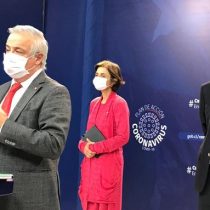
The Government went out to respond to Public Space after this study centre warned that there are a number of erroneous data in the figures delivered by the Ministry of Health (Minsal) in its Epidemiological Report on the progression of coronavirus.
“It is necessary, it is prudent, that when a report is delivered, the people who analyze these reports read them complete,” said Health Minister Jaime Mañalich, when he was consulted about it this morning during the delivery of the daily balance of the state of the coronavirus in Chile. Yesterday, the study center delivered a 6-page report, prepared by Camila Arroyo, Eduardo Engel, Diego Pardow and Pablo Simonetti, where he warned that the “Minsal epidemiological report published on April 13, included contagion data per week that, unlike the usual measurements, consider the date when the infected felt the first symptoms, causing a mismatch in the data”.
As an example, they point out that the epidemiological report figures report 599 infected for the week of April 5-11, which is much lower than the 1,559 reported in the daily reports. With the corrected data, it is confirmed that there has been an acceleration in case growth in the Metropolitan Region, and there is no “sharp drop” in the number of new contagions in the country and in the Metropolitan Region.
Methodological change
However, the argument given by the Minsal is that there was no error and it is only a methodological change that was warned. “Indeed, in the report of the previous week, the glossary clearly stipulates this change in methodology that we have been asked of by all scientific societies, the information table, because we know that a person can be infective from the beginning of the symptoms and to model this epidemic is a more contingent information,” the health holder said this morning.
Mañalich’s approach was reinforced by the Undersecretary of Public Health, Paula Daza, who confirmed that “a methodological change has been made with respect to the report and we can already have information on how much the symptom started. This allows us to take much more rigorous action to have more accurate information from the epidemiological point of view to continue taking the appropriate action to reduce the spread of the virus.”
Thus, Daza noted that “report 8 will probably see an increase in cases in the last week in relation to report 7,” which he stressed, is due to this methodological change.
Mañalich added that this epidemic also makes it clearer that “most people who suffer from an infection do so asymptomatically, there are international studies that say that up to 70%, that is, out of 10, three make symptoms, seven do not make symptoms especially children, adolescents, young people, and that poses a huge challenge. And I anticipate, almost certainly, that when we start doing antibody tests, the number of people we’re going to recognize that they’ve had the infection is going to be much higher than we have now.”





